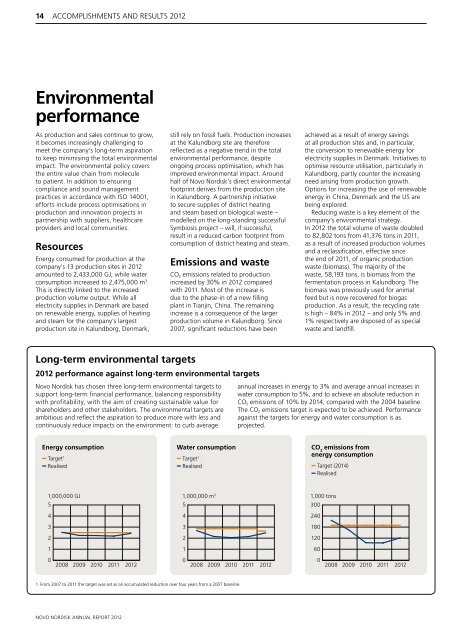Novo-Nordisk-AR-2012-en
Novo-Nordisk-AR-2012-en
Novo-Nordisk-AR-2012-en
- No tags were found...
You also want an ePaper? Increase the reach of your titles
YUMPU automatically turns print PDFs into web optimized ePapers that Google loves.
14 ACCOMPLISHMENTS AND RESULTS <strong>2012</strong><br />
Environm<strong>en</strong>tal<br />
performance<br />
As production and sales continue to grow,<br />
it becomes increasingly chall<strong>en</strong>ging to<br />
meet the company’s long-term aspiration<br />
to keep minimising the total <strong>en</strong>vironm<strong>en</strong>tal<br />
impact. The <strong>en</strong>vironm<strong>en</strong>tal policy covers<br />
the <strong>en</strong>tire value chain from molecule<br />
to pati<strong>en</strong>t. In addition to <strong>en</strong>suring<br />
compliance and sound managem<strong>en</strong>t<br />
practices in accordance with ISO 14001,<br />
efforts include process optimisations in<br />
production and innovation projects in<br />
partnership with suppliers, healthcare<br />
providers and local communities.<br />
Resources<br />
Energy consumed for production at the<br />
company’s 13 production sites in <strong>2012</strong><br />
amounted to 2,433,000 GJ, while water<br />
consumption increased to 2,475,000 m 3 .<br />
This is directly linked to the increased<br />
production volume output. While all<br />
electricity supplies in D<strong>en</strong>mark are based<br />
on r<strong>en</strong>ewable <strong>en</strong>ergy, supplies of heating<br />
and steam for the company’s largest<br />
production site in Kalundborg, D<strong>en</strong>mark,<br />
Long-term <strong>en</strong>vironm<strong>en</strong>tal targets<br />
<strong>2012</strong> performance against long-term <strong>en</strong>vironm<strong>en</strong>tal targets<br />
<strong>Novo</strong> <strong>Nordisk</strong> has chos<strong>en</strong> three long-term <strong>en</strong>vironm<strong>en</strong>tal targets to<br />
support long-term financial performance, balancing responsibility<br />
with profitability, with the aim of creating sustainable value for<br />
shareholders and other stakeholders. The <strong>en</strong>vironm<strong>en</strong>tal targets are<br />
ambitious and reflect the aspiration to produce more with less and<br />
continuously reduce impacts on the <strong>en</strong>vironm<strong>en</strong>t: to curb average<br />
Energy consumption<br />
Target 1<br />
Realised<br />
1,000,000 GJ<br />
5<br />
4<br />
3<br />
2<br />
1<br />
0<br />
2008 2009 2010 2011 <strong>2012</strong><br />
1. From 2007 to 2011 the target was set as an accumulated reduction over four years from a 2007 baseline.<br />
NOVO NORDISK ANNUAL REPORT <strong>2012</strong><br />
still rely on fossil fuels. Production increases<br />
at the Kalundborg site are therefore<br />
reflected as a negative tr<strong>en</strong>d in the total<br />
<strong>en</strong>vironm<strong>en</strong>tal performance, despite<br />
ongoing process optimisation, which has<br />
improved <strong>en</strong>vironm<strong>en</strong>tal impact. Around<br />
half of <strong>Novo</strong> <strong>Nordisk</strong>’s direct <strong>en</strong>vironm<strong>en</strong>tal<br />
footprint derives from the production site<br />
in Kalundborg. A partnership initiative<br />
to secure supplies of district heating<br />
and steam based on biological waste –<br />
modelled on the long-standing successful<br />
Symbiosis project – will, if successful,<br />
result in a reduced carbon footprint from<br />
consumption of district heating and steam.<br />
Emissions and waste<br />
CO 2 emissions related to production<br />
increased by 30% in <strong>2012</strong> compared<br />
with 2011. Most of the increase is<br />
due to the phase-in of a new filling<br />
plant in Tianjin, China. The remaining<br />
increase is a consequ<strong>en</strong>ce of the larger<br />
production volume in Kalundborg. Since<br />
2007, significant reductions have be<strong>en</strong><br />
Water consumption<br />
Target 1<br />
Realised<br />
1,000,000 m 3<br />
5<br />
4<br />
3<br />
2<br />
1<br />
0<br />
2008 2009 2010 2011 <strong>2012</strong><br />
achieved as a result of <strong>en</strong>ergy savings<br />
at all production sites and, in particular,<br />
the conversion to r<strong>en</strong>ewable <strong>en</strong>ergy for<br />
electricity supplies in D<strong>en</strong>mark. Initiatives to<br />
optimise resource utilisation, particularly in<br />
Kalundborg, partly counter the increasing<br />
need arising from production growth.<br />
Options for increasing the use of r<strong>en</strong>ewable<br />
<strong>en</strong>ergy in China, D<strong>en</strong>mark and the US are<br />
being explored.<br />
Reducing waste is a key elem<strong>en</strong>t of the<br />
company’s <strong>en</strong>vironm<strong>en</strong>tal strategy.<br />
In <strong>2012</strong> the total volume of waste doubled<br />
to 82,802 tons from 41,376 tons in 2011,<br />
as a result of increased production volumes<br />
and a reclassification, effective since<br />
the <strong>en</strong>d of 2011, of organic production<br />
waste (biomass). The majority of the<br />
waste, 58,193 tons, is biomass from the<br />
ferm<strong>en</strong>tation process in Kalundborg. The<br />
biomass was previously used for animal<br />
feed but is now recovered for biogas<br />
production. As a result, the recycling rate<br />
is high – 84% in <strong>2012</strong> – and only 5% and<br />
1% respectively are disposed of as special<br />
waste and landfill.<br />
annual increases in <strong>en</strong>ergy to 3% and average annual increases in<br />
water consumption to 5%, and to achieve an absolute reduction in<br />
CO 2 emissions of 10% by 2014, compared with the 2004 baseline.<br />
The CO 2 emissions target is expected to be achieved. Performance<br />
against the targets for <strong>en</strong>ergy and water consumption is as<br />
projected.<br />
CO 2 emissions from<br />
<strong>en</strong>ergy consumption<br />
300<br />
240<br />
Target (2014)<br />
Realised<br />
1,000 tons<br />
180<br />
120<br />
60<br />
0<br />
2008 2009 2010 2011 <strong>2012</strong>



